Cockatoos
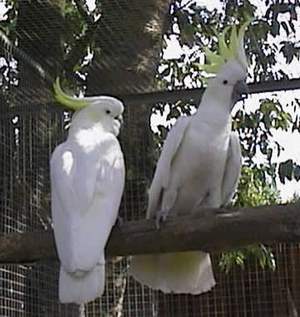
Cockatoos can be found in rainforests around the world in their natural environment and nest in hollow trees
Breeding
Love birds

Diet
Lifespan
Toucan
Toucans live in almost any kind of forest in the neotropics from Central America to northern Argentina. and are usaly found in hollowed out trees or logs.
Diet
The beak may play a role in breeding but the more likely use is to allow it to exploit a feeding niche. Some observations suggest that the beak is an adaptation that allows the toucan to delve deep into treeholes. This gives it access to prey such as nestlings and bats that may roost in such cavities—a rather sinister behavior for such a cute bird! Another unique feature of toucans is a fringed tongue, a feature it shares with woodpeckers. Other authors suggest that the beak serves as a threat display to frighten birds whose nests they plunder.
All toucans nest in tree cavities. Smaller species, such as aracaris nest in holes excavated by woodpeckers whereas large toucans (such as the yellow-ridged toucan). will choose any well-hidden cavity. Aracaris often nest communally, presumably to spread the risk from predators.
The clutch size is two to four white eggs, up to six in some species. The eggs are relatively small for the birds' size, for reasons that are not clear. After about three weeks incubation, the chicks hatch. Lacking down, the chicks have red naked skin. The feathers grow slowly, so that even after a month, bare skin may still be showing.
The young typically fledge within two months of hatching. Parents continue to feed the fledglings up to 10 days after they leave the nest.
Macaw
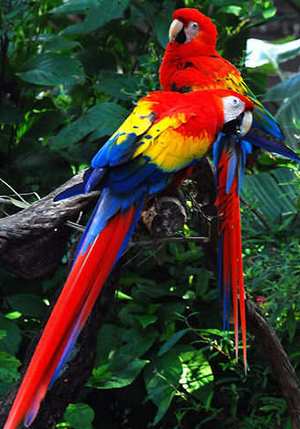
Cobia
Before the Macaw's decline in population, its distribution included much of Costa Rica. However, by the 1960s Macaws had been decreasing in numbers due to a combination of factors, particularly hunting, poaching, and the destruction of habitat through deforestation. Further, the spraying of pesticides by companies cultivating and selling bananas for export played a significant role in decreasing Scarlet Macaw populations.
The combined factors stressed the population of Scarlet Macaws in Costa Rica, where they had previously occupied approximately 42,500 km² of the country's total national territory of 51,100 km², leaving viable populations in the early 1990s isolated to only two regions on the Pacific Coast of Costa Rica; the Carara Biological reserve and Peninsula de osa. By 1993 surveys had shown macaws occupied only 20% (9,100 km²) of their historic range in Costa Rica.
The habitat of Scarlet Macaws is considered to be the greatest latitudinal range for any bird in the genus Ara, as the estimated maximum territorial range covers 6,700,000 km². Nevertheless, the Scarlet macaw’s habitat is fragmented, and colonies of the bird are mostly confined to tiny populations scattered throughout Central and South America. However, as they still occur in large numbers in some parts of their territory, where they are described as "common," the World conservation unionevaluated the species in 2004 as "Least Concern".
Quaker
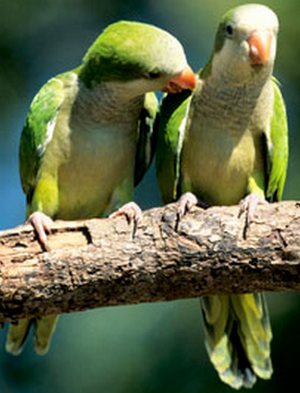
Barring accident or disease, a Quaker can be expected to live around 20-30 years.
Ringneck

The Alexandrine Parakeet, Psittacula eupatria, is a parrot which is a resident breeder from India and Sri Lanke to Southeast Asia.
It undergoes local movements, driven mainly by the availability of the fruit, seeds and blossoms, which make up its diet. The Alexandrine Parakeet is a bird of forest, open woodland and cultivation. It is scarce in much of its range. '
Diet
Wild Indian Ringnecks usually feast on a diet of fruits, vegetables, nuts, berries, and seeds. While most vets agree that it is best for captive birds to eat a nutritionally balanced pelleted diet, a Ringneck will appreciate a variety of fruits and veggies in their diet. As with all birds, food and water containers should be emptied, cleaned, and refilled daily to reduce the risk of bacteria growth and infection.
Breeding
Indian Ringnecks are relatively easy to breed. They will reach sexual maturity at about 1 1/12 years of age, but may not breed for 2 or 3 years.
It is best to separate breeding pairs from other ringnecks (in a communal / aviary setting), as they may become aggressive during this time.
Ringnecks kept in an indoor aviary will usually begin breeding in December, while birds kept in outdoor aviaries may be tempted to start in February and in many parts of the world where temperatures are still pretty low -- this can cause problems such as egg binding, chilled eggs, etc. Depending on where you live, you may want to remove the nesting boxes until temperatures are more conducive to successful breeding outcome -- such as April or May. The average clutch size is 3 to 5 eggs. The incubation period lasts an average of 23 days and the babies usually fledge when they are about 7 weeks old
RIngneck Parrots do much better in a large flight or aviary then a cage as they can be active flyers.They are best housed one pair per flight in which pairs can not see each other. The reason for this is that ringnecks do not form very strong pair bonds and are known for flirting and distracting mates of other pairs.
Life span
Between 25 - 30 years, although instances of Ringnecks living past the age of fifty have been authenticated.
African Grey
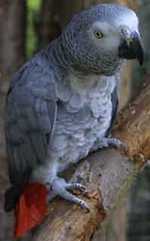
* Variety is the key here. Pelletted diets should form the foundation of the diet, but should be supplemented with a variety of fresh fruits and vegetables as well as grains and proteins. A small amount of seed mix can be fed as well, keeping in mind that seeds have some nutritional value and place in the diet but are largely fattening and poorly balanced as a main part of the diet. For a detailed discussion of diet, see "parrot nutriant 101"
* If your bird is reluctant to try new foods, see the tips in "introduceing new foods to picky eaters." Tips on switching a seed eater to a formulated (pellet) diet can be found in switching ur bird to pellets
* African greys are somewhat prone to calcium deficiency, so calcium levels should be monitored at a yearly vet check. Calcium supplements should not be used except under the advice of a veterinarian, but it can be beneficial to feed a variety of calcium rich foods such as leafy green vegetables (kale, mustard greens, Swiss chard, spinach). For more information on calcium levels in some foods, see Winged Widom
* Fresh clean water should be available at all times. Food and water dishes should be washed daily.
Ducks
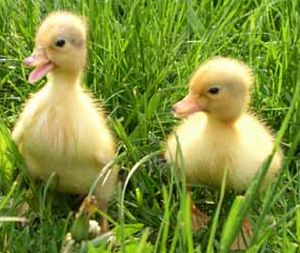
The ducks have a cosmopolitan distribution occurring across most of the world except for Antarctica. A number of species manage to live on sub-Antarctic islands like South Georgia and the Auckland Islands. Numerous ducks have managed to establish themselves on oceanic islands such as Hawaii, New Zealand and Kerguelen, although many of these species and populations are threatened or have become extinct.
Some duck species, mainly those breeding in the temperate and Arctic Northern Hemisphere, are migratory; those in the tropics, however, are generally not. Some ducks, particularly in Australia where rainfall is patchy and erratic, are nomadic, seeking out the temporary lakes and pools that form after localised heavy rain.[citation needed]
Ducks have become an accepted presence in populated areas. Migration patterns have changed such that many species remain in an area during the winter months. In spring and early summer ducks sometimes influence human activity through their nesting; sometimes a duck pair nests well away from water, needing a long trek to water for the hatchlings: this sometimes causes an urgent wildlife rescue operation (e.g. by the RSPCA) if the duck nested somewhere unsuitable like in a small enclosed courtyard.
Ducks exploit a variety of food sources such as grasses, aquatic plants, fish, insects, small amphibians[3], worms, and small molluscs.
Diving ducks and sea ducks forage deep underwater. To be able to submerge more easily, the diving ducks are heavier than dabbling ducks, and therefore have more difficulty taking off to fly.
Dabbling ducks feed on the surface of water or on land, or as deep as they can reach by up-ending without completely submerging. [4] Along the inside of the beak they have tiny rows of plates called lamellae like a whale's baleen. These let them filter water out of the side of their beaks and keep food inside.
A few specialized species such as the smew, goosander, and the mergansers are adapted to catch and swallow large fish.
The others have the characteristic wide flat beak designed for dredging-type jobs such as pulling up waterweed, pulling worms and small molluscs out of mud, searching for insect larvae, and bulk jobs such as holding and turning headfirst and swallowing a squirming frog. To avoid injury when digging into sediment it has no cere. but the nostrils come out through hard horn.
The ducks are generally monogamous, although these bonds generally last a single year only. Larger species and the more sedentary species (like fast river specialists) tend to have pair-bonds that last numerous years. Most duck species breed once a year, choosing to do so in favourable conditions (spring/summer or wet seasons).
2 to 12 years depending on what kind of duck it is.